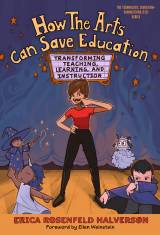And it got me thinking about, why did you want to write this book? What were the challenges that you were seeing in education that you wanted to address?
Erica: This goes back to the advent of the accountability system in the late ‘90s and early 2000s, where for very good reasons that have to do with issues of equity and inclusion, policy makers focused on metrics of success such as test scores on fixed, normed reading and math tests, and measurable outcomes like attendance metrics, as the primary way that we as a society could understand whether we were serving all of our kids.
I think that approach was fundamentally misguided—because it eliminated all of those inspiring and arts-based practices that you described that were hallmarks of our childhood teaching and learning experiences. Because all of a sudden, if what counts as good learning looks like performance on a reading test, then all of our educational efforts get laser-focused in service of performing well on those metrics.
My experience both as an artist and an arts educator, is that the outcomes of arts practice are themselves the measure of learning. Making art of any kind is an act of representation, taking an idea and giving it a form for other people to respond to. That form is anything from a painting, a song, a Tik Tok video, you name it. Art-making is an act of representation. And the ability to create an effective representation is actually the single most important skill for all classroom learning.
The challenge is, when we fix the outcome of representation as performance on an exam, then we’ve eliminated all the choices for moving around the representational process. Because we’re not really asking the fundamental questions that make learning compelling, like, What’s the idea you have? How do these tools allow you to represent that idea? And how do audiences respond to your representation as a good version of that idea? And that’s true from writing expository essays to using math equations to represent how to communicate a mathematical practice, to a complicated science experiment.
That’s a long way of saying: I think we went off the rails when we let the outcome measures of standardized learning drive the design bus.
Holly: The title of the book leads me to believe you think the arts can save education, and you have an interesting and unique perspective. Because I think people say versions of this all the time—but yours is different. It’s not necessarily more time spent in music class playing the violin.
Erica: It is remaking our systems of teaching and learning by using arts practices as the foundation for what good teaching looks like, for what good learning can be, and how our learning environments can function.
 Here’s an example: in the chapter where I talk about remaking curriculum, I describe how the process of art-making is fundamentally the cycle of coming up with an idea, creating representations and then sharing those with an audience. The strong argument I’m making is that cycle, that process is the model for how all learning experiences are designed, regardless of the discipline that you’re in. The foundation of the learning process ought to be coming up with the idea that is the subject of your inquiry, and developing tools for representation that are germane to that discipline. Every discipline has its own tools for representation. I don’t think music ought to be used necessarily for representing math, though there is a place for that.
Here’s an example: in the chapter where I talk about remaking curriculum, I describe how the process of art-making is fundamentally the cycle of coming up with an idea, creating representations and then sharing those with an audience. The strong argument I’m making is that cycle, that process is the model for how all learning experiences are designed, regardless of the discipline that you’re in. The foundation of the learning process ought to be coming up with the idea that is the subject of your inquiry, and developing tools for representation that are germane to that discipline. Every discipline has its own tools for representation. I don’t think music ought to be used necessarily for representing math, though there is a place for that.
What I’m saying is, what are the tools for representation in mathematics? And how do those tools afford you to represent the idea or concept, and then what happens when you share those representations with an audience? What kind of feedback do you get? Does that give you an opportunity to help you think about the connection between the idea that you had and the representation that you’ve chosen? Does it teach something about that idea that they didn’t already know? Either way, how should we understand what you get out of that process beyond simply knowing the facts of a particular discipline or domain.
Many of us grow up with artistic superpowers, artistic ways of knowing and doing. You don’t have to be a tuba player! These artistic superpowers could serve us productively in our inquiries into other disciplines. And that’s another way of saying, it’s not that we all need to learn the tuba, right? It’s the way of engaging in arts practice, which pretty much we all do whether you’re a cook, or you make clothes for your family, or the myriad ways we express ourselves. In education we do everyone a disservice by not acknowledging that we should be drawing on those ways of knowing and doing as an integral part of how we learn to do stuff.
Holly: Okay, I have to stop you and ask questions here. What I often see happening in classrooms is that kids don’t even know the facts. Here’s an example: my fourth grader could not learn his multiplication tables. I took him to a tutoring center, and they said, “This is so easy, there’s a scientific way that kids need to learn this stuff, and the reason he doesn’t know his times tables is because he doesn’t know the basic facts of 0-10. Once he knows those, and we will teach it to him, he will be able to multiply with ease.
What I worry about is that students have to have the basic facts first in order to enjoy this kind of learning—what you’re talking about here is a lot like project-based learning—and what we’re missing, especially most often for the most vulnerable children, is that they don’t have the basics to work with.
 Erica: I think two things. There is a place for drill and practice as a tool for acquiring information. And the arts certainly do our versions of drill and practice—if you want to become a trained singer, you spend 20 minutes a day warming up your voice, to set the conditions for being able to sing. So I’m not arguing that there is not a time and place to use those tools. I think what we miss when we say you need to start with the basics, is that cognitively if students are not ready to use those tools to make something they care about, none of it is going to stick.
Erica: I think two things. There is a place for drill and practice as a tool for acquiring information. And the arts certainly do our versions of drill and practice—if you want to become a trained singer, you spend 20 minutes a day warming up your voice, to set the conditions for being able to sing. So I’m not arguing that there is not a time and place to use those tools. I think what we miss when we say you need to start with the basics, is that cognitively if students are not ready to use those tools to make something they care about, none of it is going to stick.
Here’s an arts-based example: Video editing is an extremely technical and trying process, with many sets of technical tools, informational processes, etc. If you have no need for audio level adjustment, memorizing where and how audio level adjustment works is a bit of an act of futility. But, once you need to adjust the audio levels of an interview you’ve done—that info and knowledge, whatever you want to call it, is much more likely to become part of what you know and do if you use it than if you are in a video editing class and it was the week to learn about audio level adjustment.
The same goes for multiplication tables. We need to drill and practice in order to make that part of your memory, of course, in the same way that a video editor needs to adjust audio levels 40 times, so when it comes to being able to do that seamlessly they can do that with no problem. However, if the impetus of that drill isn’t grounded in some practice of conceiving, representing and sharing, it’s going to be much harder to motivate, much harder to sustain, and it’s going to be harder to convince young people that it matters for them.
Holly: It makes me think of Jal Mehta’s and Sarah Fine’s book “In Search of Deeper Learning.” Some kids seem to gravitate towards this kind of project-based learning. In the book, they talk about how it’s often the after-school activities that kids get so deep into—sports, the arts, marching band—because of exactly what you’re saying.
Erica: Yeah, of course, you’re going to find that in your ‘after-school’ time, because those practices are part of what it means to make things. And where are we mostly making things? We are mostly making things now outside of school time. There are often critiques of those after-school learning spaces, “But you’re only talking about the kids who opt in.” And my response has been, “That’s because we don’t give all kids the opportunity to do these things. We treat them as if they’re special. What if there was an all-in system, because this is how we do teaching and learning at scale?”
Holly: What I find most compelling about the arts when it comes to education is that it’s a different way to be smart. It gives kids who may not be particularly good at math or reading a reason to go to school. Can we talk about that? Because I feel like some of what your book is saying is that we need to recognize the different ways in which people are smart.
Erica: Yes, and I think an even stronger claim is to stop equating school performance with smartness. The problem is not with the kids, the problem is with the way we’ve set up what these learning experiences are for. What you said—well that person isn’t good at math. I would say, are they not good at math? Or, is the way that school math was designed not reflective of what it means to be smart in math?
And like, you may not like math class, but what I would hope for, is that we give more kids more chances to be smart, and enjoy more school-based disciplines, when we use these arts-based strategies to engage.
Holly: Let’s talk about your theatre company, Whoopensocker. What did you learn about traditional education from going into schools and doing these shows, where basically kids invent a show from scratch? How did that inform what you’re doing?
Erica: I think the number one thing that I learned is that good teaching and learning is built on a foundation of risk-taking. That is, learners’ willingness to take a risk, and teachers’ willingness to take a risk. Risk-taking means everything from a willingness to try out an answer and be wrong, to a willingness to take leadership, cognitive leadership or project leadership. There are a lot of ways that it looks. But my mantra is: we can’t teach or learn anything unless we are willing to take a risk.
And a thing that I’ve learned from formal learning systems of all kinds, from tutoring to college classes to K-12 school: we don’t scaffold risk-taking as a normal part of the way we design learning environments. Like, “getting to know you” games have a really bad reputation, and I think the reason is we’ve lost sight of what they’re for. What they’re for is to set the conditions for people to be able to take risks together, to learn and do new stuff.
There are many classroom teachers who do that as a natural part of their practice. When we go in with Whoopensocker, you can tell right away the classrooms that are set up to do that kind of risk-taking.
We always start with warm-up games for everyone. In classroom spaces that are not scaffolded for risk-taking, sometimes that is as far as we get in the first few weeks, just getting learners and teachers to do a call and response game altogether, which is its own form of risk. In classrooms that are set up for risk-taking, they are ready from the jump to contribute new ideas and let those ideas be a dialogue.
What I have learned from being an arts educator for 25 years in elementary school classrooms, is that scaffolding risk-taking is the single most important feature of an effective learning environment.
Holly: This is the perfect lead-in to my next question: How are teachers going to incorporate these ideas? What I see when I go into classrooms is teachers who are teaching a mile a minute. They have a stack of standards, of things they have to say and do on specific days. It feels like there is no room for them to incorporate this.
Erica: We can’t afford for there not to be room. The kids who are consistently left out of the system, and this has not changed one iota since No Child Left Behind, are still being left out. Accountability systems have not created universally more successful schooling or equitable schooling.
So I would argue that we need to ditch the content-forward, content-pressured model of schooling, in service of scaffolding risk-taking as the mechanism into much deeper and more meaningful understanding of concepts and information and how they’re represented in a discipline. I know as an individual classroom teacher, that’s not a super-helpful comment, because that’s a system-level response.
This only happens if we all collectively acknowledge that sticking things in the margins is not the way to systemic change. When you clean out your closet, how often are you shoving tee shirts into a drawer before you finally say, this drawer can’t hold any more tee shirts? And you dump the whole drawer out?
The model of, “how do we shove more pieces into an already packed agenda?” is never going to get us anywhere.
Holly: If there is one thing that you would like teachers to think about when they’re done reading this book, what would it be? What could they do today?




 Erica:
Erica: